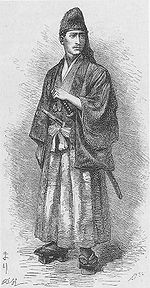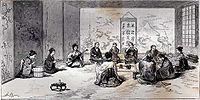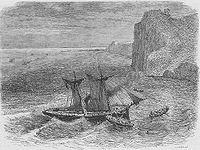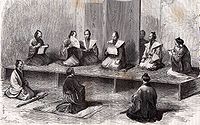
Eugène Collache
Encyclopedia

French Navy
The French Navy, officially the Marine nationale and often called La Royale is the maritime arm of the French military. It includes a full range of fighting vessels, from patrol boats to a nuclear powered aircraft carrier and 10 nuclear-powered submarines, four of which are capable of launching...
in the 19th century. Based on the ship Minerva of the French Oriental Fleet, he deserted when the ship was anchored at Yokohama
Yokohama
is the capital city of Kanagawa Prefecture and the second largest city in Japan by population after Tokyo and most populous municipality of Japan. It lies on Tokyo Bay, south of Tokyo, in the Kantō region of the main island of Honshu...
harbour, with his friend Henri Nicol
Henri Nicol
Henri Paul Hipolito Nicol was an officer of the French Navy in the 19th century. Based on the ship Minerva of the French Oriental Fleet, he deserted when the ship was anchored at Yokohama harbour, with his friend Eugène Collache to rally other French officers, led by Jules Brunet, who had embraced...
to rally other French officers, led by Jules Brunet
Jules Brunet
Jules Brunet was a French officer who played an active role in Mexico and Japan, and later became a General and Chief of Staff of the French Minister of War in 1898...
, who had embraced the cause of the Bakufu in the Boshin War
Boshin War
The was a civil war in Japan, fought from 1868 to 1869 between forces of the ruling Tokugawa shogunate and those seeking to return political power to the imperial court....
. On November 29, 1868, Eugène Collache and Nicol left Yokohama
Yokohama
is the capital city of Kanagawa Prefecture and the second largest city in Japan by population after Tokyo and most populous municipality of Japan. It lies on Tokyo Bay, south of Tokyo, in the Kantō region of the main island of Honshu...
on board a commercial ship, the Sophie-Hélène, chartered by a Swiss businessman.

Nambu
Nanbu may refer to:* Nanbu, Aomori, Japan* Nanbu, Tottori, Japan* Nanbu, Wakayama, in Wakayama Prefecture, Japan* Nanbu, Yamanashi, Japan* Nanbu County, Sichuan Province, China...
(modern Miyagi Prefecture
Miyagi Prefecture
is a prefecture of Japan in the Tōhoku Region on Honshu island. The capital is Sendai.- History :Miyagi Prefecture was formerly part of the province of Mutsu. Mutsu Province, on northern Honshu, was one of the last provinces to be formed as land was taken from the indigenous Emishi, and became the...
), where they learned that the Imperial forces had subdued the Daimyos of Northern Japan, and that the rebel forces favorable to the Shogun had fled to the island of Hokkaidō
Hokkaido
, formerly known as Ezo, Yezo, Yeso, or Yesso, is Japan's second largest island; it is also the largest and northernmost of Japan's 47 prefectural-level subdivisions. The Tsugaru Strait separates Hokkaido from Honshu, although the two islands are connected by the underwater railway Seikan Tunnel...
. They decided to go further north to Aomori
Aomori Prefecture
is a prefecture of Japan located in the Tōhoku Region. The capital is the city of Aomori.- History :Until the Meiji Restoration, the area of Aomori prefecture was known as Mutsu Province....
, where they were warmly received by the Daimyo
Daimyo
is a generic term referring to the powerful territorial lords in pre-modern Japan who ruled most of the country from their vast, hereditary land holdings...
of Tsugaru
Tsugaru Peninsula
The is a peninsula in Aomori Prefecture, at the northern end of Honshū island, Japan. The peninsula projects north into the Tsugaru Strait separating Honshū from Hokkaidō. The western coast is on the Sea of Japan, while on its eastern coast are Aomori Bay and Mutsu Bay...
. A visiting American ship brought them the news that an arrestation order against them had been issued. Eugène Collache and Nicol decided to board the American ship and reached Hokkaidō. During the winter of 1868-1869, Collache was put in charge of establishing fortifications in the volcanic mountain chain protecting Hakodate (Nicol was put in charge of organizing the Navy).
On May 18, the decision was taken to make a surprise attack on the Imperial Navy, which was moving north to confront them. Collache thus participated to the Naval Battle of Miyako. He was on the Takao
Japanese steam warship Takao
was a steam warship belonging to the former navy of the Bakufu during the Boshin War of 1868-1869. She had been seized from the navy of the fief of Akita....
, former Aschwelotte, which he was commanding. The two other ships were the Kaiten
Japanese warship Kaiten
The Japanese warship was a warship of the troops loyal to the Shogun during the Boshin War in Japan in 1868. She was armed with 13 cannons, had a complement of 153 men, a displacement of 710 tons, and an engine of 400 hp capable of generating a speed of 12 knots. Her length was 68.4 meters, width...
and the Banryu
Japanese warship Banryu
The Japanese warship was a ship of the Bakufu Navy, and subsequently belonged to the troops loyal to the Shogun during the Boshin War in Japan in 1868. Banryū was originally built in England as a schooner, where she had been named Emperor. She had a length of 41.8 meters, a breadth of 5.45 meters,...
. The ships encountered bad weather, in which the Takao suffered from engine trouble, and the Banryu was separated. The Banryu eventually returned to Hokkaidō, without joining the battle.



Edo
, also romanized as Yedo or Yeddo, is the former name of the Japanese capital Tokyo, and was the seat of power for the Tokugawa shogunate which ruled Japan from 1603 to 1868...
to be imprisoned. He was judged and condemned to death, but he was finally pardoned. He was transferred to Yokohama
Yokohama
is the capital city of Kanagawa Prefecture and the second largest city in Japan by population after Tokyo and most populous municipality of Japan. It lies on Tokyo Bay, south of Tokyo, in the Kantō region of the main island of Honshu...
on board the French Navy frigate Coëtlogon, where he joined the remaining of the French rebel officers led by Jules Brunet
Jules Brunet
Jules Brunet was a French officer who played an active role in Mexico and Japan, and later became a General and Chief of Staff of the French Minister of War in 1898...
.
During his adventure, Eugène Collache wore the Japanese dress, whether on the contrary some of his Japanese military colleagues wore Western uniforms:
- "It was the first time a European thus crossed Japan, and everybody wanted to see him; but my hairless face, my suntanned skin, and my Japanese clothes misled the curious, who then thought that the European man was a certain Japanese officer who wore a moustache and had the uniform of an American Navy officer." Eugène Collache, "Une aventure au Japon", in "Le Tour du Monde", p59
Back in France, he was dismissed from the army and judged as a deserter, but the sanctions were light, and he was allowed to reintegrate the French army to participate to the Franco-Prussian War
Franco-Prussian War
The Franco-Prussian War or Franco-German War, often referred to in France as the 1870 War was a conflict between the Second French Empire and the Kingdom of Prussia. Prussia was aided by the North German Confederation, of which it was a member, and the South German states of Baden, Württemberg and...
with his friend Nicol.
He wrote "An Adventure in Japan 1868 - 1869" ("Une aventure au Japon 1868-1869"), which was published in 1874.

